Uncertainty Analysis of CO2 Storage in Deep Saline Aquifers Using Machine Learning and Bayesian Optimization
Abstract
1. Introduction
2. Materials and Methods
2.1. Governing Model
2.2. Machine Learning Approach
2.3. Johansen Aquifer Model: A Real Case Example
2.4. Proposed Workflow
2.4.1. Step 1: Dataset Generation
2.4.2. Step 2: Generate a ML-Based Predictive Model
- Root-mean-square Error (RMSE) is the standard deviation of the residuals (prediction errors), which is a measure of the distance of the regression line from the data points. RMSE is given by:
- Coefficient of determination (R2) is a statistical measure of fit that indicates the amount of variation between actual and predicted values. R2 of 1 means the data are perfectly matched. R2 is calculated using the following equation:
2.4.3. Step 3: Uncertainty Quantification and Global Sensitivity Analysis
3. Results and Discussion
3.1. Base Case Simulation Result
- Structural—CO2 residually trapped inside a structural trap.
- Residual—CO2 residually trapped outside any structural traps.
- Residual in the plume fraction of the CO2 plume outside any structural traps will be left behind as residually trapped droplets when the plume migrates away from its current position.
- Structural plume—mobile CO2 volume that is currently contained within a residual trap; if the containing structure is breached, this volume is free to migrate upward.
- Free plume—the fraction of the CO2 plume outside of structural traps that is free to migrate upward and/or be displaced by imbibing brine.
- Exited “leaked”—the volume of CO2 that has leaked out of the domain through its lateral boundaries.
3.2. Generating Training Dataset for the ML Model
3.3. Monte Carlo Simulations
4. Conclusions
- High-resolution numerical simulations (open-source MATLAB package: MRST-CO2lab) are conducted to investigate the various trapping mechanisms and total CO2 storage capacity, where the Johansen Aquifer is used as a real case application in this study. The simulation results are then used as a sample input in the ML model.
- The ML model, Artificial Neural Network (ANN), with time term as an input coupled with Bayesian optimization, was trained and used to predict the contribution of different trapping mechanisms.
- The accuracy achieved with the ANN corresponds to RMSE and R2 values of 0.00783 and 0.9988, respectively. Thus, the proposed ML model demonstrates robustness and accuracy in comparison with the numerical reservoir simulator.
- Monte Carlo simulations with 5000 runs, based on the optimized ML, are performed to explore the uncertainty propagation of time-series model outputs for each storage mechanism. Two distinct trends among the five investigated storage mechanisms are identified, namely residual and free plume mechanisms. The observed trends offer quantitative evaluations for each storage mechanism over different periods.
- First-order Sobol indices are used to identify the most influential paraments in the model’s predictions. The top three crucial input parameters are injection rate (Q), residual CO2 saturation (SCO2), and water saturation (Srw). Their order of significance varies depending on the specific storage mechanisms. Note that the injection rate is typically a major uncertainty parameter.
- The conclusions obtained by the global sensitivity analysis offer insights into the most influential time-series contributors, which could ensure better management during large-scale CO2 sequestration.
Author Contributions
Funding
Data Availability Statement
Acknowledgments
Conflicts of Interest
References
- IPCC. Climate Change 2021: The Physical Science Basis. Contribution of Working Group I to the Sixth Assessment Report of the Intergovernmental Panel on Climate Change; Cambridge University Press: Cambridge, UK; New York, NY, USA, 2021; in press. [Google Scholar]
- Keeling, C.D.; Bacastow, R.B.; Bainbridge, A.E.; Ekdahl, C.A., Jr.; Guenther, P.R.; Waterman, L.S.; Chin, J.F.S. Atmospheric carbon dioxide variations at Mauna Loa Observatory, Hawaii. Tellus 1976, 28, 538–551. [Google Scholar] [CrossRef]
- Metz, B.; Davidson, O.; de Coninck, H.C.; Loos, M.; Meyer, L. IPCC Special Report on Carbon Dioxide Capture and Storage; Cambridge University Press: Cambridge, UK, 2005; ISBN 978-0-521-68551-1. [Google Scholar]
- Rose, S.K.; Richels, R.; Blanford, G.; Rutherford, T. The Paris Agreement and next steps in limiting global warming. Clim. Chang. 2017, 142, 255–270. [Google Scholar] [CrossRef]
- Hoteit, H.; Fahs, M.; Soltanian, M.R. Assessment of CO2 Injectivity during Sequestration in Depleted Gas Reservoirs. Geosciences 2019, 9, 199. [Google Scholar] [CrossRef]
- Underschultz, J.; Boreham, C.; Dance, T.; Stalker, L.; Freifeld, B.; Kirste, D.; Ennis-King, J. CO2 storage in a depleted gas field: An overview of the CO2CRC Otway Project and initial results. Int. J. Greenh. Gas Control. 2011, 5, 922–932. [Google Scholar] [CrossRef]
- Iglauer, S. Dissolution Trapping of Carbon Dioxide in Reservoir Formation Brine—A Carbon Storage Mechanism; IntechOpen: Rijeka, Croatia, 2011; ISBN 978-953-307-636-2. [Google Scholar]
- Nilsen, H.M.; Lie, K.-A.; Andersen, O. Fully-implicit simulation of vertical-equilibrium models with hysteresis and capillary fringe. Comput. Geosci. 2016, 20, 49–67. [Google Scholar] [CrossRef]
- White, C.M.; Smith, D.H.; Jones, K.L.; Goodman, A.L.; Jikich, S.A.; LaCount, R.B.; DuBose, S.B.; Ozdemir, E.; Morsi, B.I.; Schroeder, K.T. Sequestration of Carbon Dioxide in Coal with Enhanced Coalbed Methane RecoveryA Review. Energy Fuels 2005, 19, 659–724. [Google Scholar] [CrossRef]
- IEA. CO2 Storage in Depleted Gas Field; IEA: Paris, France, 2009. [Google Scholar]
- Arkadakskiy, S.; Oelkers, E.H.; Afifi, A.; Hoteit, H.; Gislason, S.R.; Kunnummal, N.; Ahmed, Z. The Potential for Sequestering CO2 in Basalts along the Red Sea Coast of Saudi Arabia. In Proceedings of the AGU Fall Meeting Abstracts, Chicago, IL, USA, 12–16 December 2020; Volume 2020, p. GC111-05. [Google Scholar]
- Oelkers, E.H.; Arkadakskiy, S.; Afifi, A.M.; Hoteit, H.; Richards, M.; Fedorik, J.; Delaunay, A.; Torres, J.E.; Ahmed, Z.T.; Kunnummal, N.; et al. The subsurface carbonation potential of basaltic rocks from the Jizan region of Southwest Saudi Arabia. Int. J. Greenh. Gas Control. 2022, 120, 103772. [Google Scholar] [CrossRef]
- Hoteit, H.; Addassi, M. Integrated Uncertainty Quantification for Reactive Transport Modeling of CO2 Mineralization in Basalts. 3rd EAGE Geochem. Workshop 2021, 2021, 1–5. [Google Scholar] [CrossRef]
- Javaheri, M.; Abedi, J.; Hassanzadeh, H. Onset of Convection in CO2 Sequestration in Deep Inclined Saline Aquifers. J. Can. Pet. Technol. 2009, 48, 22–27. [Google Scholar] [CrossRef]
- Hamieh, A.; Rowaihy, F.; Al-Juaied, M.; Abo-Khatwa, A.N.; Afifi, A.M.; Hoteit, H. Quantification and analysis of CO2 footprint from industrial facilities in Saudi Arabia. Energy Convers. Manag. X 2022, 16, 100299. [Google Scholar] [CrossRef]
- Corrales, M.; Mantilla Salas, S.; Tasianas, A.; Hoteit, H.; Afifi, A. The Potential for Underground CO2 Disposal Near Riyadh. In Proceedings of the International Petroleum Technology Conference, Riyadh, Saudi Arabia, 21–23 February 2022; OnePetro: Riyadh, Saudi Arabia, 2022. [Google Scholar]
- Temitope, A.; Gomes, J.S.; Al Kobaisi, M.; Hu, J. Characterization and Quantification of the CO2 Sequestration Potential of a Carbonate Aquifer in Falaha Syncline, Onshore Abu Dhabi; OnePetro: Abu Dhabi, United Arab Emirates, 2016. [Google Scholar]
- Zhang, H.; Arif, M.; Al Kobaisi, M. A Numerical Evaluation of the Impact of Wettability on CO2 Trapping Capacity: Implications for Carbon Geo-Sequestration; OnePetro: Abu Dhabi, United Arab Emirates, 2022. [Google Scholar]
- Wang, Y.; Vuik, C.; Hajibeygi, H. Analysis of hydrodynamic trapping interactions during full-cycle injection and migration of CO2 in deep saline aquifers. Adv. Water Resour. 2022, 159, 104073. [Google Scholar] [CrossRef]
- Kumar, A.; Noh, M.; Ozah, R.; Pope, G.; Bryant, S.; Sepehrnoori, K.; Lake, L. Reservoir Simulation of CO2 Storage in Deep Saline Aquifers. SPE J. 2005, 10, 336–348. [Google Scholar] [CrossRef]
- Ali, M.; Yekeen, N.; Pal, N.; Keshavarz, A.; Iglauer, S.; Hoteit, H. Influence of pressure, temperature and organic surface concentration on hydrogen wettability of caprock; implications for hydrogen geo-storage. Energy Rep. 2021, 7, 5988–5996. [Google Scholar] [CrossRef]
- Omar, A.; Addassi, M.; Vahrenkamp, V.; Hoteit, H. Co-Optimization of CO2 Storage and Enhanced Gas Recovery Using Carbonated Water and Supercritical CO2. Energies 2021, 14, 7495. [Google Scholar] [CrossRef]
- Clavijo, S.P.; Addassi, M.; Finkbeiner, T.; Hoteit, H. A coupled phase-field and reactive-transport framework for fracture propagation in poroelastic media. Sci. Rep. 2022, 12, 17819. [Google Scholar] [CrossRef]
- Shafabakhsh, P.; Ataie-Ashtiani, B.; Simmons, C.T.; Younes, A.; Fahs, M. Convective-reactive transport of dissolved CO2 in fractured-geological formations. Int. J. Greenh. Gas Control. 2021, 109, 103365. [Google Scholar] [CrossRef]
- Soltanian, M.R.; Amooie, M.A.; Gershenzon, N.; Dai, Z.; Ritzi, R.; Xiong, F.; Cole, D.; Moortgat, J. Dissolution Trapping of Carbon Dioxide in Heterogeneous Aquifers. Environ. Sci. Technol. 2017, 51, 7732–7741. [Google Scholar] [CrossRef]
- Addassi, M.; Omar, A.; Ghorayeb, K.; Hoteit, H. Comparison of various reactive transport simulators for geological carbon sequestration. Int. J. Greenh. Gas Control. 2021, 110, 103419. [Google Scholar] [CrossRef]
- Addassi, M.; Omar, A.; Hoteit, H.; Alafifi, A.M.; Arkadakskiy, S.; Ahmed, Z.T.; Kunnummal, N.; Gislason, S.R.; Oelkers, E.H. Assessing the potential of solubility trapping in unconfined aquifers for subsurface carbon storage. Sci. Rep. 2022, 12, 20452. [Google Scholar]
- Ali, M.; Yekeen, N.; Pal, N.; Keshavarz, A.; Iglauer, S.; Hoteit, H. Influence of organic molecules on wetting characteristics of mica/H2/brine systems: Implications for hydrogen structural trapping capacities. J. Colloid Interface Sci. 2022, 608, 1739–1749. [Google Scholar] [CrossRef]
- Ahmadi, M.A.; Chen, Z. Analytical Model for Leakage Detection in CO2 Sequestration in Deep Saline Aquifers: Application to ex Situ and in Situ CO2 Sequestration Processes. ACS Omega 2019, 4, 21381–21394. [Google Scholar] [CrossRef] [PubMed]
- Qiao, T.; Hoteit, H.; Fahs, M. Semi-Analytical Solution to Assess CO2 Leakage in the Subsurface through Abandoned Wells. Energies 2021, 14, 2452. [Google Scholar] [CrossRef]
- Hesse, M.A.; Tchelepi, H.A.; Orr, F.M. Scaling Analysis of the Migration of CO2 in Saline Aquifers; OnePetro: San Antonio, TX, USA, 2006. [Google Scholar]
- Zhang, Z.; He, X.; AlSinan, M.; Li, Y.; Kwak, H.; Hoteit, H. Deep Learning Model for CO2 Leakage Detection Using Pressure Measurements. In Proceedings of the SPE Annual Technical Conference and Exhibition; OnePetro: Houston, TX, USA, 2022. [Google Scholar]
- He, X.; Zhu, W.; Santoso, R.; Alsinan, M.; Kwak, H.; Hoteit, H. CO2 Leakage Rate Forecasting Using Optimized Deep Learning; OnePetro: Dubai, United Arab Emirates, 2021. [Google Scholar]
- Yan, B.; Harp, D.R.; Chen, B.; Hoteit, H.; Pawar, R.J. A gradient-based deep neural network model for simulating multiphase flow in porous media. J. Comput. Phys. 2022, 463, 111277. [Google Scholar]
- Santoso, R.; He, X.; Hoteit, H. Application of machine-learning to construct simulation models from high-resolution fractured formation. In Proceedings of the Society of Petroleum Engineers—Abu Dhabi International Petroleum Exhibition and Conference, Abu Dhabi, United Arab Emirates, 11–14 November 2019. [Google Scholar] [CrossRef]
- Li, H.; Gong, C.; Liu, S.; Xu, J.; Imani, G. Machine Learning-Assisted Prediction of Oil Production and CO2 Storage Effect in CO2-Water-Alternating-Gas Injection (CO2-WAG). Appl. Sci. 2022, 12, 10958. [Google Scholar] [CrossRef]
- Ahmadi, M.A.; Zendehboudi, S.; James, L.A. Developing a robust proxy model of CO2 injection: Coupling Box–Behnken design and a connectionist method. Fuel 2018, 215, 904–914. [Google Scholar] [CrossRef]
- Al-Mudhafar, W.J. Polynomial and nonparametric regressions for efficient predictive proxy metamodeling: Application through the CO2-EOR in shale oil reservoirs. J. Nat. Gas Sci. Eng. 2019, 72, 103038. [Google Scholar] [CrossRef]
- You, J.; Ampomah, W.; Sun, Q.; Kutsienyo, E.J.; Balch, R.S.; Dai, Z.; Cather, M.; Zhang, X. Machine learning based co-optimization of carbon dioxide sequestration and oil recovery in CO2-EOR project. J. Clean. Prod. 2020, 260, 120866. [Google Scholar] [CrossRef]
- Vo Thanh, H.; Lee, K.-K. Application of machine learning to predict CO2 trapping performance in deep saline aquifers. Energy 2022, 239, 122457. [Google Scholar] [CrossRef]
- Riis, F.; Halland, E. CO2 Storage Atlas of the Norwegian Continental Shelf: Methods Used to Evaluate Capacity and Maturity of the CO2 Storage Potential. Energy Procedia 2014, 63, 5258–5265. [Google Scholar] [CrossRef]
- SINTEF The MATLAB Reservoir Simulation Toolbox (MRST). MRST 2015. Available online: https://www.sintef.no/projectweb/mrst/ (accessed on 1 December 2022).
- Lie, K.-A. An Introduction to Reservoir Simulation Using MATLAB/GNU Octave: User Guide for the MATLAB Reservoir Simulation Toolbox (MRST); Cambridge University Press: Cambridge, UK, 2019; ISBN 978-1-108-49243-0. [Google Scholar]
- Ahmed, T.; Nasrabadi, H.; Firoozabadi, A. Complex Flow and Composition Path in CO2 Injection Schemes from Density Effects. Energy Fuels 2012, 26, 4590–4598. [Google Scholar] [CrossRef]
- Nordbotten, J.M.; Flemisch, B.; Gasda, S.E.; Nilsen, H.M.; Fan, Y.; Pickup, G.E.; Wiese, B.; Celia, M.A.; Dahle, H.K.; Eigestad, G.T.; et al. Uncertainties in practical simulation of CO2 storage. Int. J. Greenh. Gas Control. 2012, 9, 234–242. [Google Scholar] [CrossRef]
- Jan Martin Nordbotten, M.A.C. Geological Storage of CO2: Modeling Approaches for Large-Scale Simulation, 1st ed.; Wiley: New York, NY, USA, 2011; ISBN 0-470-88946-2. [Google Scholar]
- Ligaarden, I.; Nilsen, H. Numerical Aspects of Using Vertical Equilibrium Models for Simulating CO2 Sequestration. In Proceedings of the ECMOR 12th European Conference on the Mathematics of Oil Recovery, Oxford, UK, 6–9 September 2010. [Google Scholar] [CrossRef]
- Span, R.; Wagner, W. A New Equation of State for Carbon Dioxide Covering the Fluid Region from the Triple-Point Temperature to 1100 K at Pressures up to 800 MPa. J. Phys. Chem. Ref. Data 1996, 25, 1509–1596. [Google Scholar] [CrossRef]
- Nilsen, H.M.; Lie, K.-A.; Andersen, O. Robust simulation of sharp-interface models for fast estimation of CO2 trapping capacity in large-scale aquifer systems. Comput. Geosci. 2016, 20, 93–113. [Google Scholar] [CrossRef]
- Alqahtani, A.S. New Polymer Rheology Models Based on Machine Learning. Master’s Thesis, the University of Texas at Austin, Austin, TX, USA, 2019. [Google Scholar]
- Norvig, P.; Russell, S. Artificial Intelligence: A Modern Approach; Pearson Education: London, UK, 2011; ISBN 978-0-13-300198-3. [Google Scholar]
- SINTEF the MATLAB Reservoir Simulation Toolbox: Numerical CO2 Laboratory. MRST-co2lab 2014.
- Halland, E.; Mujezinović, J.; Riis, F. CO2 Storage Atlas: Norwegian Continental Shelf; The Norwegian Petroleum Directorate: Stavanger, Norway, 2014. [Google Scholar]
- Abbaszadeh, M.; Shariatipour, S.M. Investigating the Impact of Reservoir Properties and Injection Parameters on Carbon Dioxide Dissolution in Saline Aquifers. Fluids 2018, 3, 76. [Google Scholar] [CrossRef]
- Liu, B.; Zhang, Y. CO2 Modeling in a Deep Saline Aquifer: A Predictive Uncertainty Analysis Using Design of Experiment. Environ. Sci. Technol. 2011, 45, 3504–3510. [Google Scholar] [CrossRef] [PubMed]
- Stein, M. Large sample properties of simulations using latin hypercube sampling. Technometrics 1987, 29, 143–151. [Google Scholar] [CrossRef]
- He, X.; Santoso, R.; Alsinan, M.; Kwak, H.; Hoteit, H. Constructing Dual-Porosity Models from High-Resolution Discrete-Fracture Models Using Deep Neural Networks; OnePetro: Richardson, TX, USA, 2021. [Google Scholar]
- Santoso, R.; Hoteit, H.; Vahrenkamp, V. Optimization of energy recovery from geothermal reservoirs undergoing re-injection: Conceptual application in Saudi Arabia. In Proceedings of the SPE Middle East Oil and Gas Show and Conference, MEOS, Manama, Bahrain, 18–21 March 2019; Society of Petroleum Engineers (SPE): Houston, TX, USA, 2019; Volume 2019. [Google Scholar]
- Santoso, R.; Torrealba, V.; Hoteit, H. Investigation of an improved polymer flooding scheme by compositionally-tuned slugs. Processes 2020, 8, 197. [Google Scholar]
- Kim, Y.; Jang, H.; Kim, J.; Lee, J. Prediction of storage efficiency on CO2 sequestration in deep saline aquifers using artificial neural network. Appl. Energy 2017, 185, 916–928. [Google Scholar] [CrossRef]
- Marelli, S.; Sudret, B. UQLab: A Framework for Uncertainty Quantification in Matlab. In Vulnerability, Uncertainty, and Risk: Quantification, Mitigation, and Management; American Society of Civil Engineers: Reston, VA, USA, 2014. [Google Scholar]
- Sahu, Q.; Fahs, M.; Hoteit, H. Optimization and Uncertainty Quantification Method for Reservoir Stimulation through Carbonate Acidizing. ACS Omega 2023, 8, 539–554. [Google Scholar] [CrossRef]
- Marelli, S.; Lamas, C.; Sudret, B. UQLab User Manual—Sensitivity Analysis. Rep. UQLab-V1 2015, 2–106. [Google Scholar] [CrossRef]
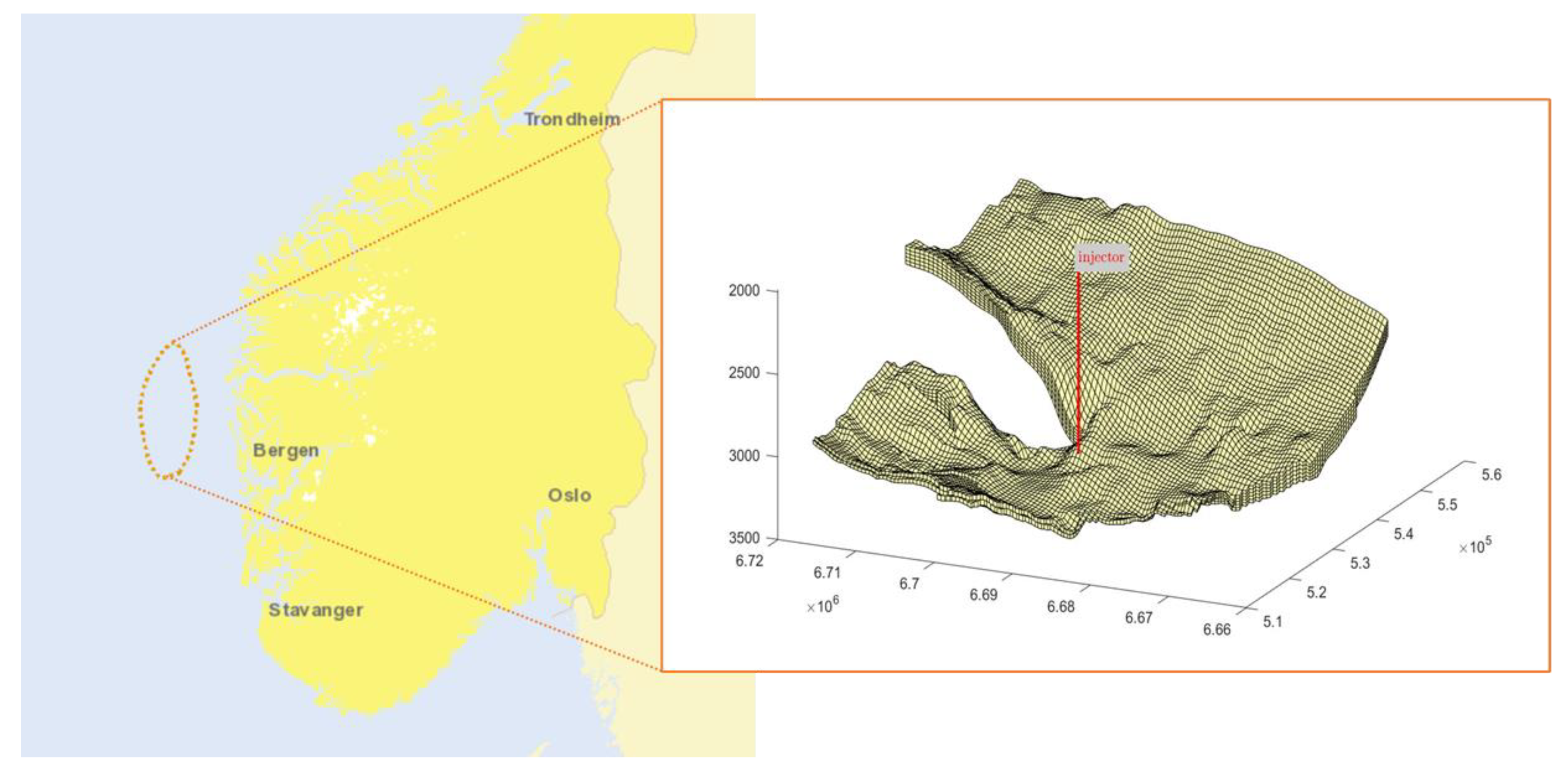
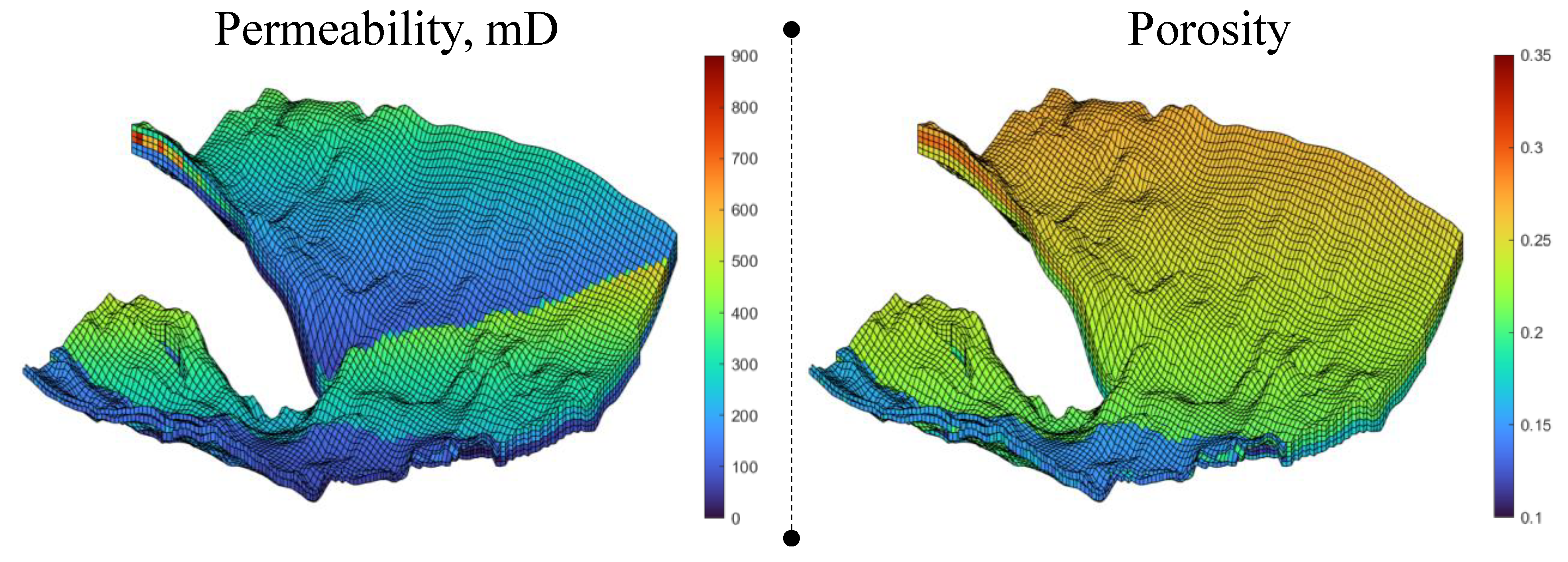
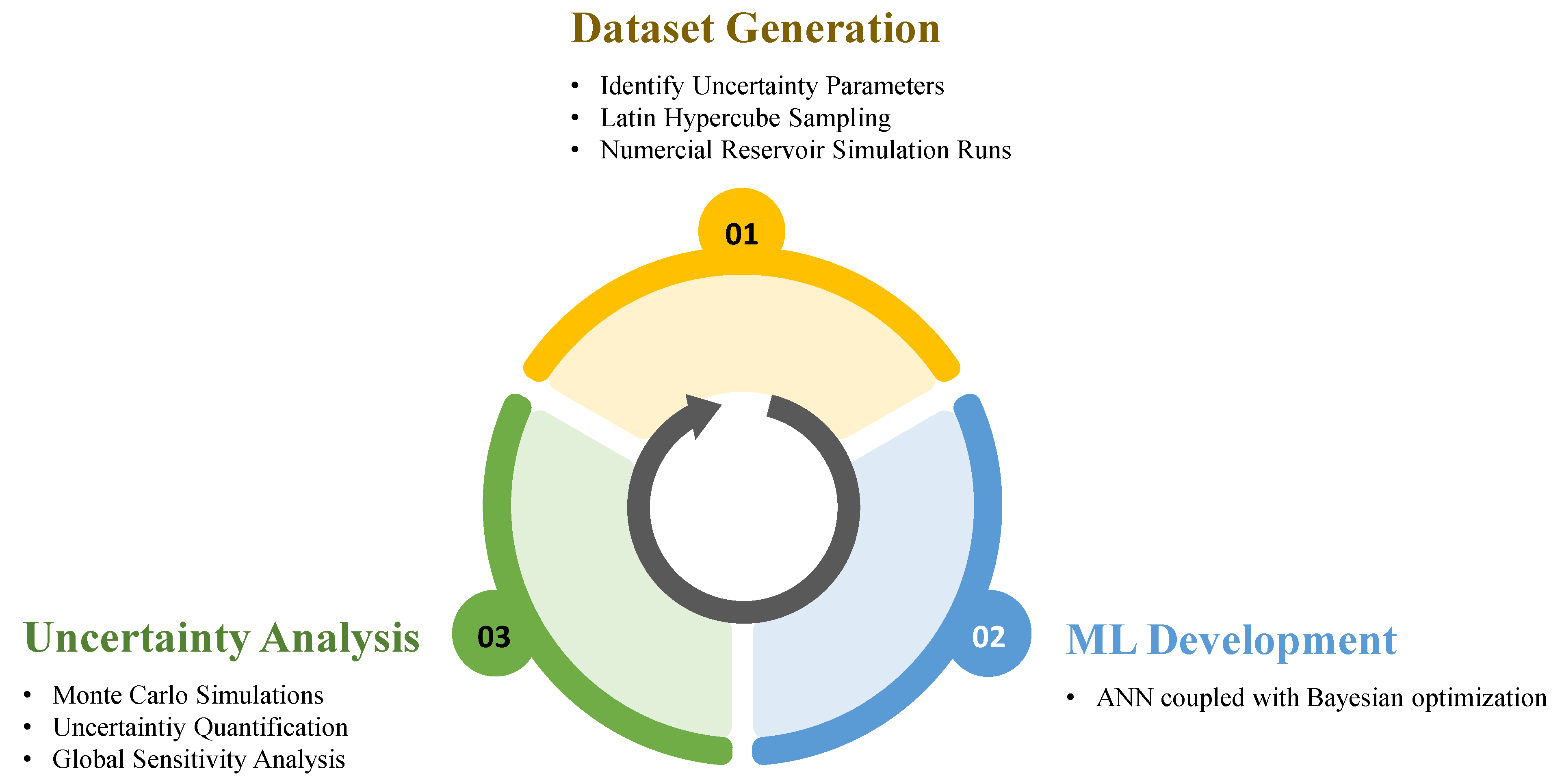
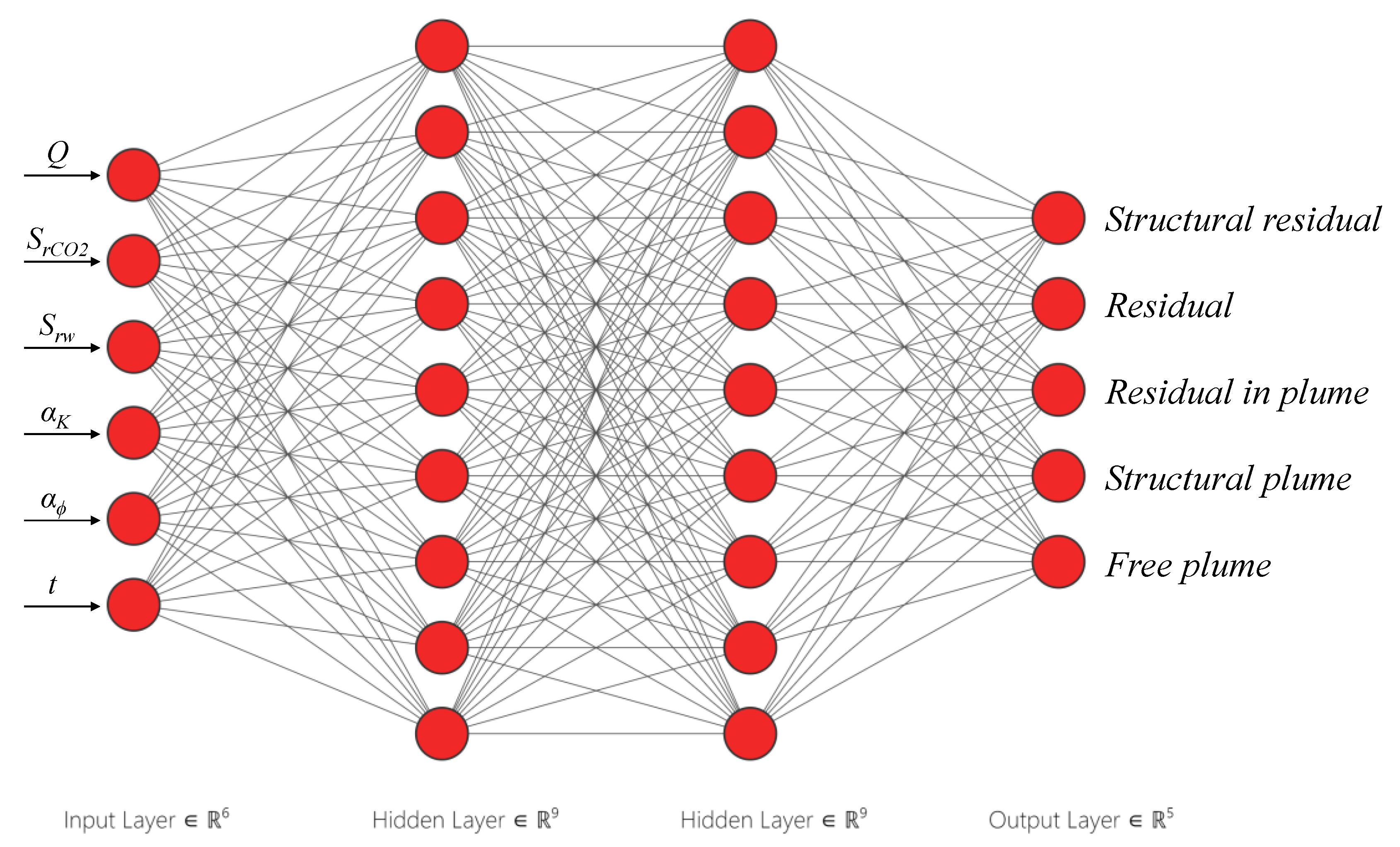
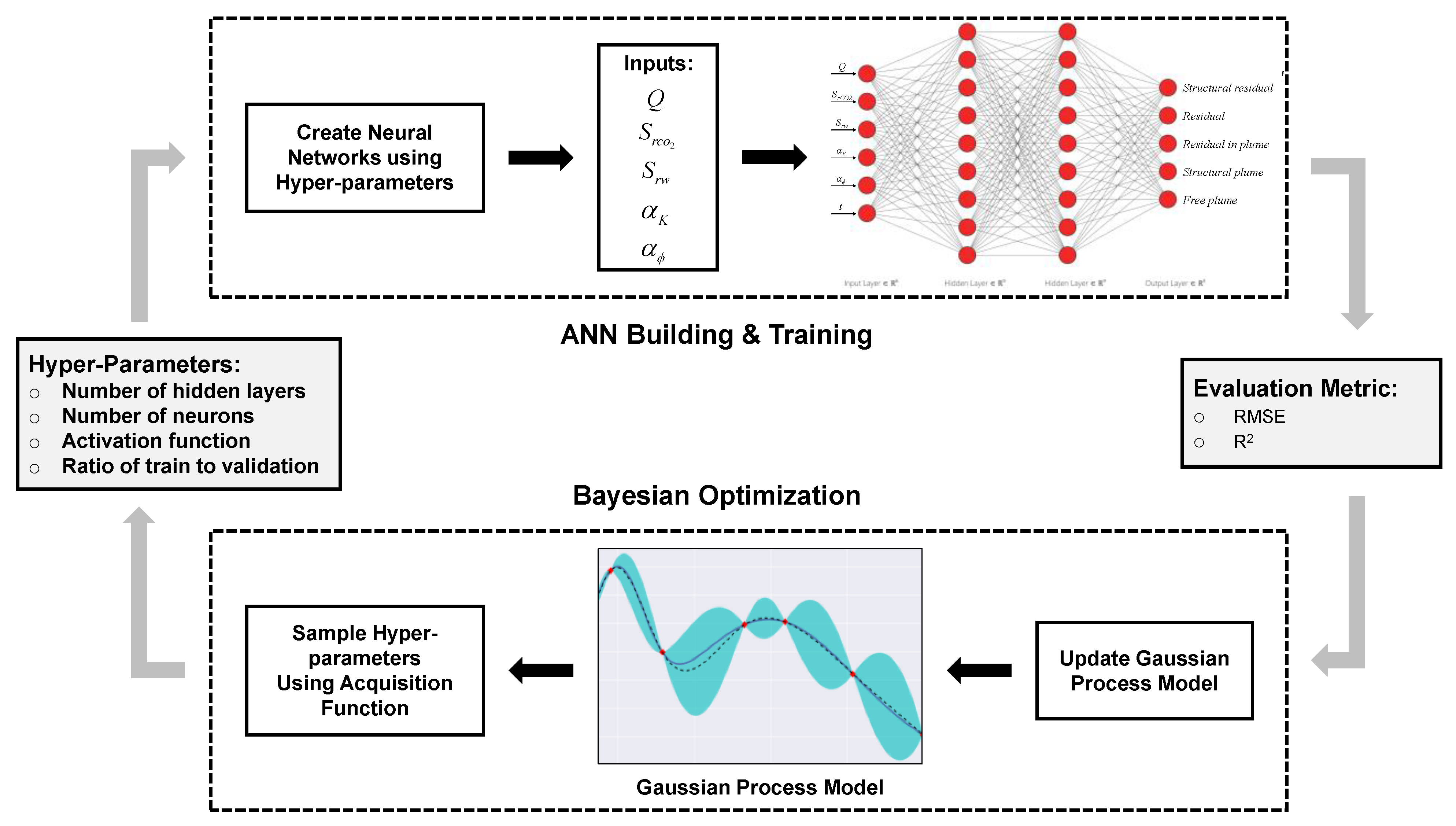
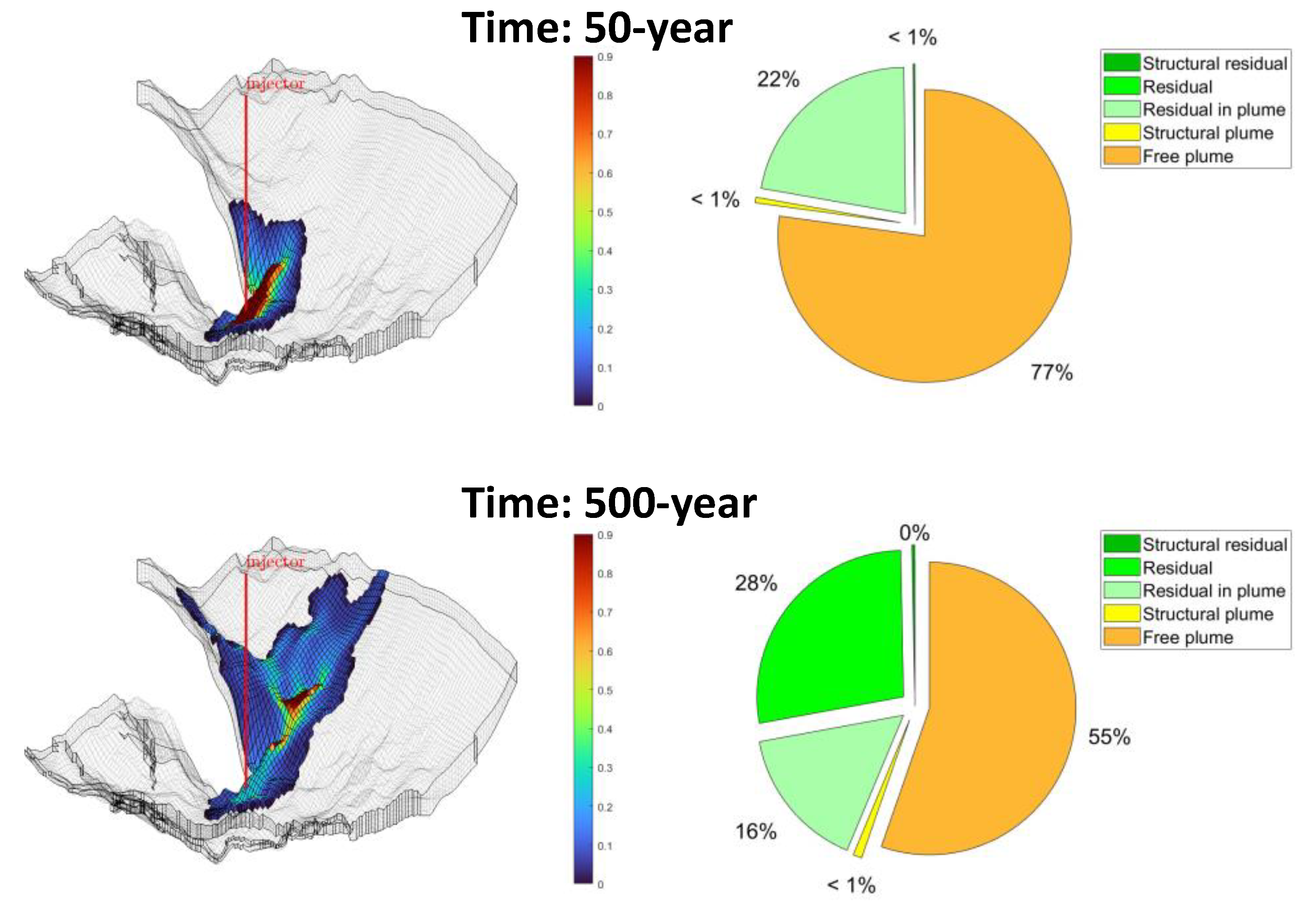
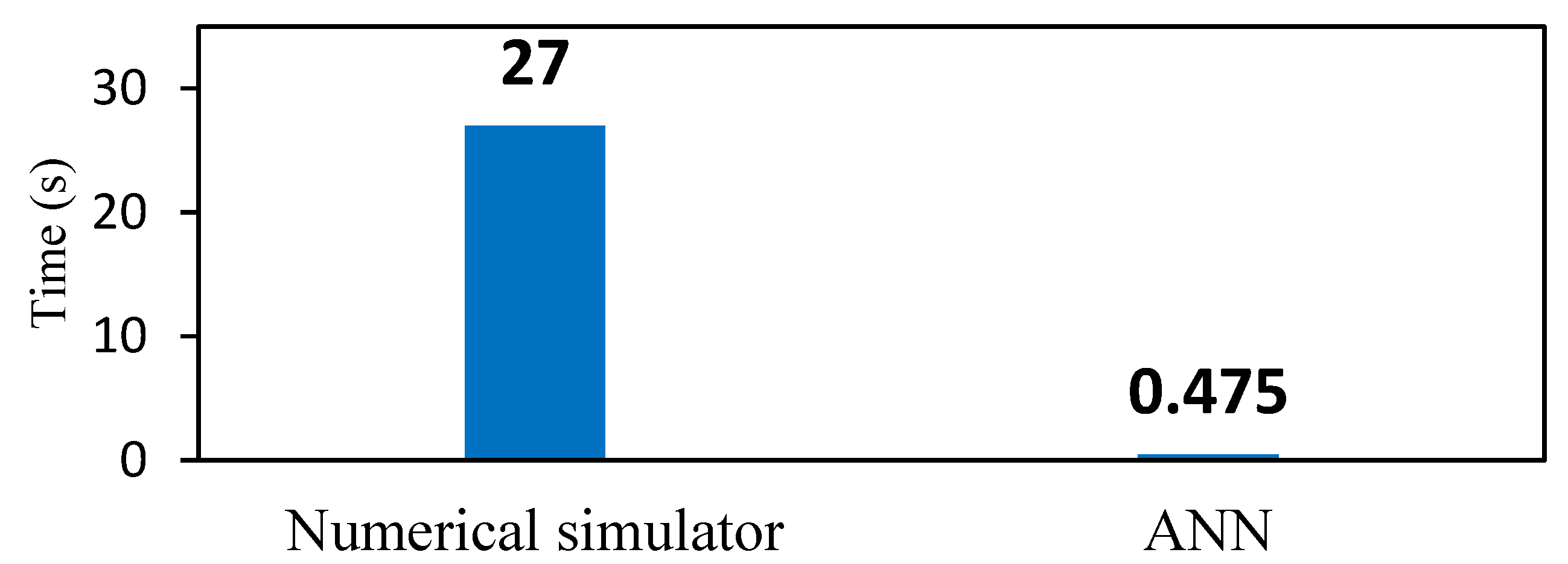
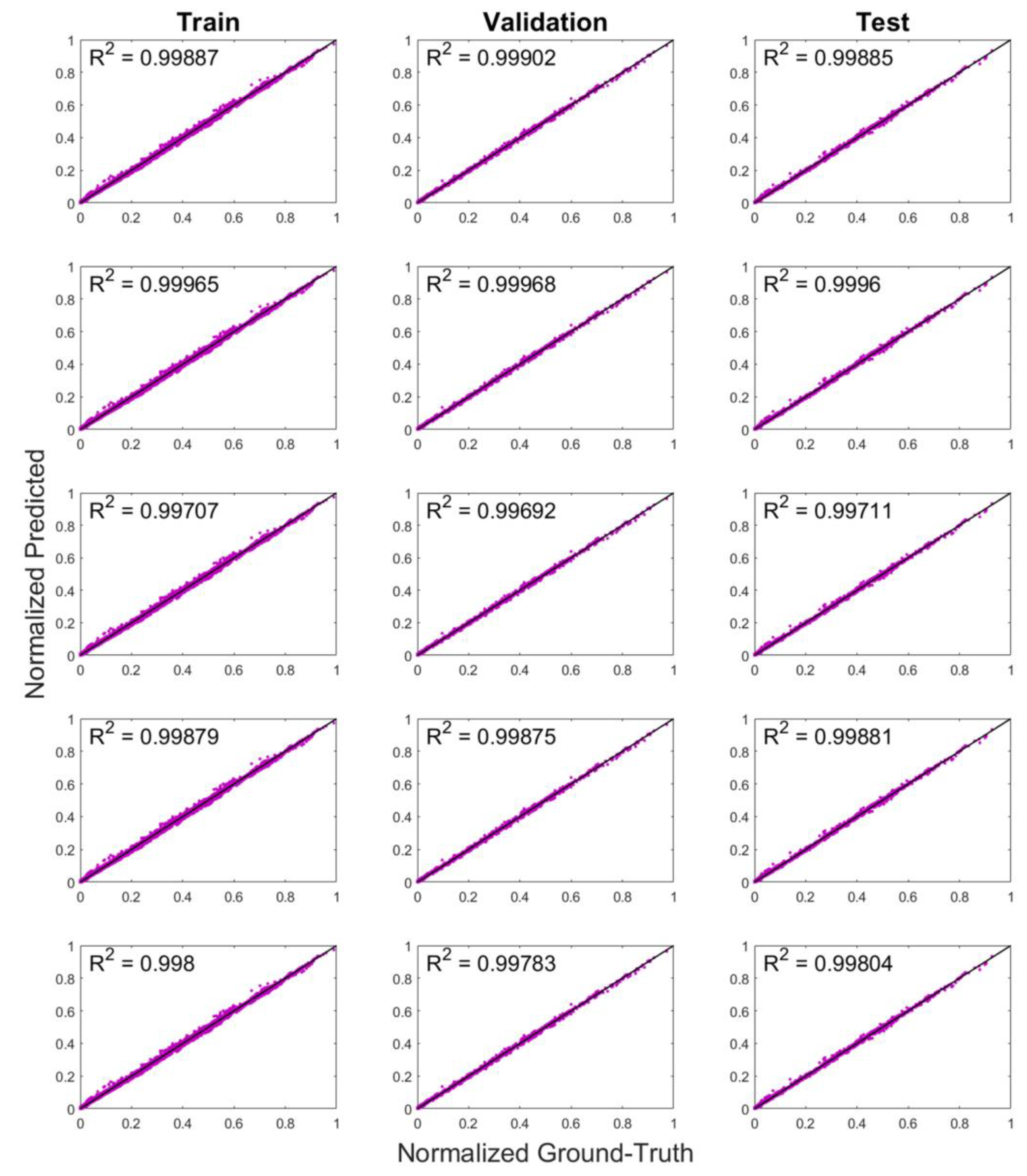
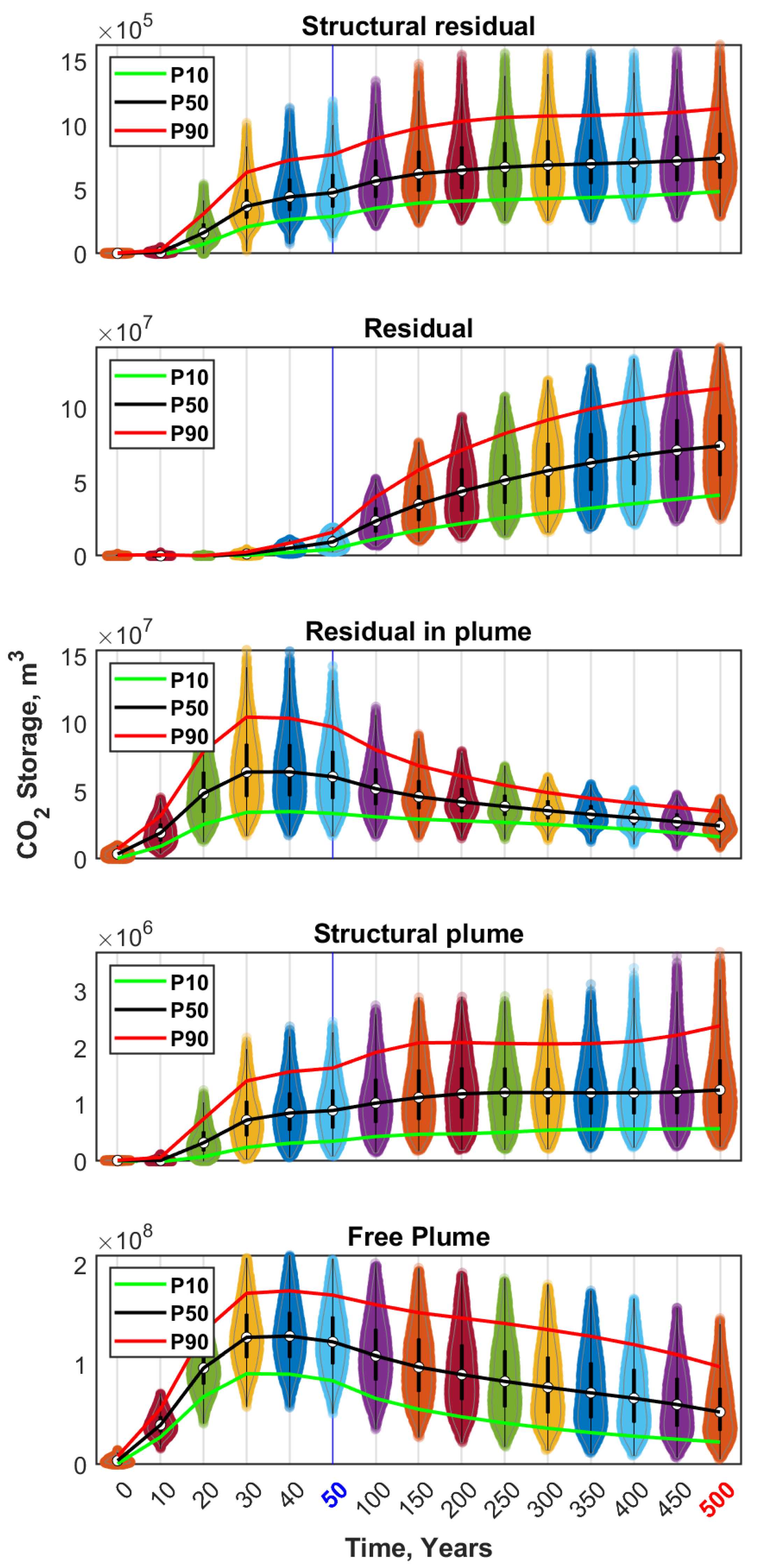
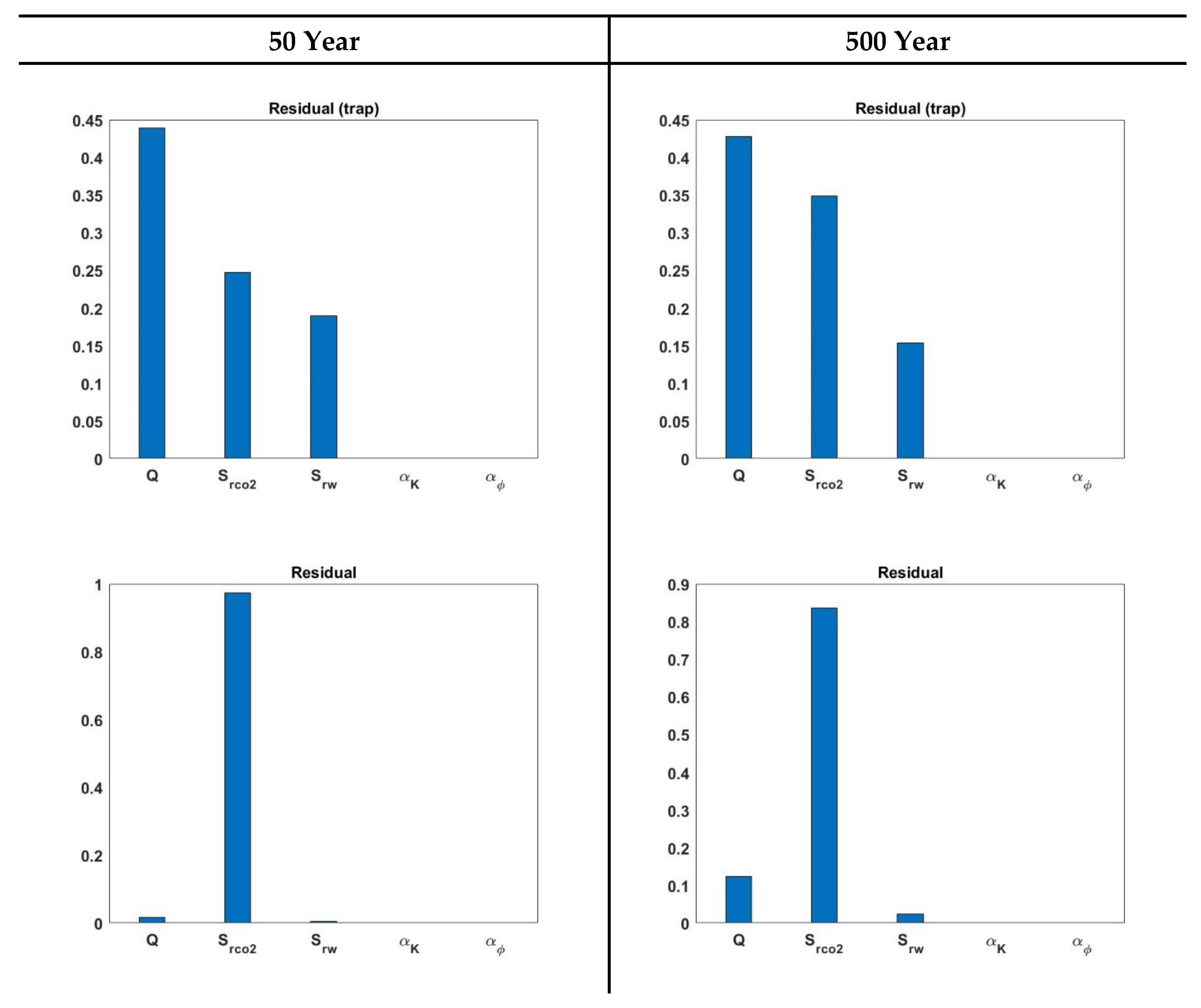
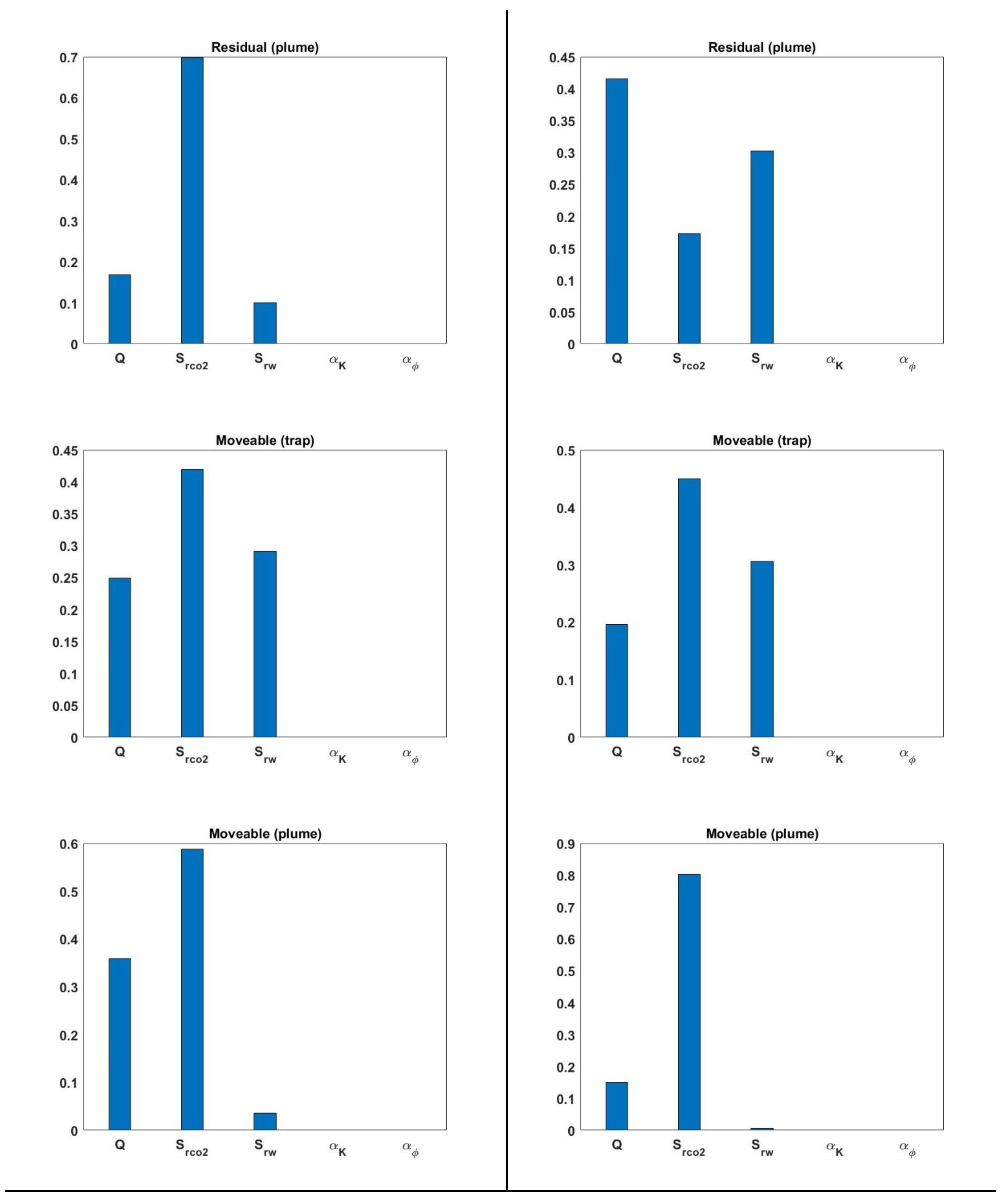
| Parameter | Base Case Value |
|---|---|
| CO2 injection rate Q | 8000 m3/day |
| Residual CO2 saturation Srco2 | 0.2 |
| Residual water saturation Srw | 0.1 |
| Permeability K | 233 mD (Avg.) |
| Porosity | 22% (Avg.) |
| Fluid properties | ρco2 = 686.54 ρw = 975.86 kg/m3 μco2 = 0.056641 μw = 0.30860 cp |
| Injection period | 50 years |
| Post-injection (migration) period | 450 years |
| Uncertainty Parameters | Lower Bound | Upper Bound |
|---|---|---|
| CO2 injection rate Q | 8000 m3/day | 14,000 m3/day |
| Residual CO2 saturation Srco2 | 0.1 | 0.4 |
| Residual water saturation Srw | 0.1 | 0.4 |
| Permeability coefficient αK | 0.8 | 1.4 |
| Porosity coefficient αϕ | 0.8 | 1.4 |
| Tuned Hyper-Parameter | ANN |
|---|---|
| Number of hidden layers | 3 |
| Neurons per hidden layer | [8 6 5] |
| Activation Function | Sigmoid |
| Indicator | Train | Validation | Test |
|---|---|---|---|
| RMSE | 0.00797 | 0.00808 | 0.00783 |
| R2 | 0.9988 | 0.9988 | 0.9988 |
Disclaimer/Publisher’s Note: The statements, opinions and data contained in all publications are solely those of the individual author(s) and contributor(s) and not of MDPI and/or the editor(s). MDPI and/or the editor(s) disclaim responsibility for any injury to people or property resulting from any ideas, methods, instructions or products referred to in the content. |
© 2023 by the authors. Licensee MDPI, Basel, Switzerland. This article is an open access article distributed under the terms and conditions of the Creative Commons Attribution (CC BY) license (https://creativecommons.org/licenses/by/4.0/).
Share and Cite
Alqahtani, A.; He, X.; Yan, B.; Hoteit, H. Uncertainty Analysis of CO2 Storage in Deep Saline Aquifers Using Machine Learning and Bayesian Optimization. Energies 2023, 16, 1684. https://doi.org/10.3390/en16041684
Alqahtani A, He X, Yan B, Hoteit H. Uncertainty Analysis of CO2 Storage in Deep Saline Aquifers Using Machine Learning and Bayesian Optimization. Energies. 2023; 16(4):1684. https://doi.org/10.3390/en16041684
Chicago/Turabian StyleAlqahtani, Abdulwahab, Xupeng He, Bicheng Yan, and Hussein Hoteit. 2023. "Uncertainty Analysis of CO2 Storage in Deep Saline Aquifers Using Machine Learning and Bayesian Optimization" Energies 16, no. 4: 1684. https://doi.org/10.3390/en16041684
APA StyleAlqahtani, A., He, X., Yan, B., & Hoteit, H. (2023). Uncertainty Analysis of CO2 Storage in Deep Saline Aquifers Using Machine Learning and Bayesian Optimization. Energies, 16(4), 1684. https://doi.org/10.3390/en16041684







